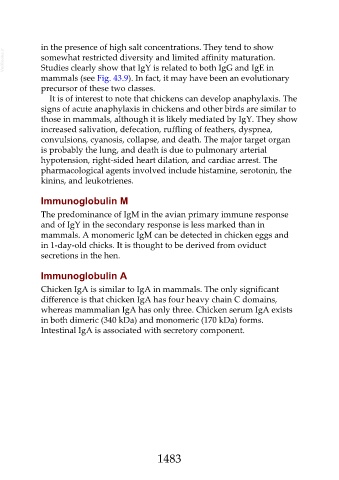Page 1483 - Veterinary Immunology, 10th Edition
P. 1483
in the presence of high salt concentrations. They tend to show
VetBooks.ir somewhat restricted diversity and limited affinity maturation.
Studies clearly show that IgY is related to both IgG and IgE in
mammals (see Fig. 43.9). In fact, it may have been an evolutionary
precursor of these two classes.
It is of interest to note that chickens can develop anaphylaxis. The
signs of acute anaphylaxis in chickens and other birds are similar to
those in mammals, although it is likely mediated by IgY. They show
increased salivation, defecation, ruffling of feathers, dyspnea,
convulsions, cyanosis, collapse, and death. The major target organ
is probably the lung, and death is due to pulmonary arterial
hypotension, right-sided heart dilation, and cardiac arrest. The
pharmacological agents involved include histamine, serotonin, the
kinins, and leukotrienes.
Immunoglobulin M
The predominance of IgM in the avian primary immune response
and of IgY in the secondary response is less marked than in
mammals. A monomeric IgM can be detected in chicken eggs and
in 1-day-old chicks. It is thought to be derived from oviduct
secretions in the hen.
Immunoglobulin A
Chicken IgA is similar to IgA in mammals. The only significant
difference is that chicken IgA has four heavy chain C domains,
whereas mammalian IgA has only three. Chicken serum IgA exists
in both dimeric (340 kDa) and monomeric (170 kDa) forms.
Intestinal IgA is associated with secretory component.
1483

